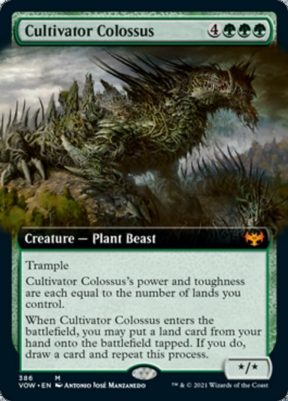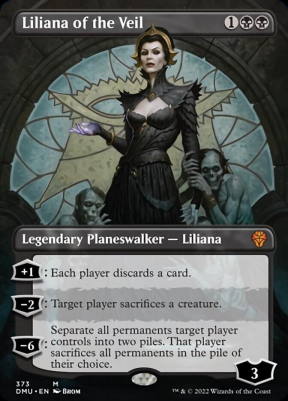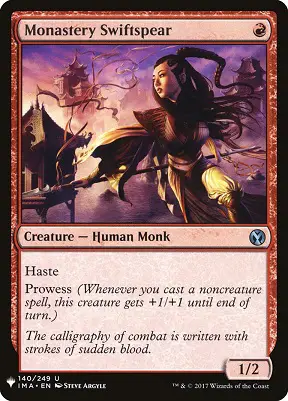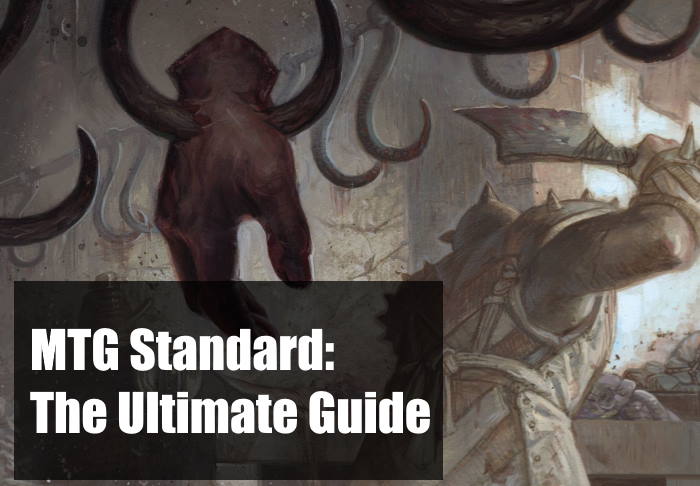Created in 1995 under the initial name “Type 2,” Standard is one of the most popular formats in all of MTG. Before we dive into the nuts and bolts of the format, it’s important to understand what Standard is.
Standard is a rotating format. This means that only cards from the most recent sets are allowed to be played in Standard; the older sets usually rotate out of the format every fall. Most expansions are legal in Standard for about two years at a time. In Standard, players construct 60-card decks along with a 15-card sideboard.
Read on for an in depth look at the Standard format, including which sets are currently legal, when the next rotation is, and more.
Table Of Contents:
- What Sets are Currently Legal in Standard?
- What are the Upcoming Standard Sets that Release This Year?
- When Does Standard Rotate?
- FAQs
- What Cards are Banned?
- What is the Current Meta?
- What are the Best Decks in Standard?
- End Step
What Sets Are Currently Legal in Standard?
The current sets that are legal in Standard are:
- Innistrad Midnight Hunt
- Innistrad Crimson Vow
- Kamigawa: Neon Dynasty
- Streets of New Capenna
- Dominaria United
- The Brother’s War
What are the Upcoming Standard Sets?
The upcoming sets that will be released as a part of the current Standard are:
- Phyrexia All Will Be One (February 10, 2023)
- March of the Machine (April 21, 2023)
Phyrexia All Will Be One
Phyrexia All Will Be One releases February 10th and picks up where Dominaria United left off in terms of story. Elesh Norn and the phyrexians move ever closer to their goal of dominating the multiverse.
March of the Machine
March of the Machine releases April 21, and will conclude the story of the New Phyrexians’ attempt to conquer the multiverse. Since this set is pretty far away, we don’t yet know any details about the cards or mechanics to come.
When Does Standard Rotate?
Traditionally, Standard rotation occurs in the fall. The actual date, however, varies. This past year Standard rotated in September 2022. At any given time, there are between 5-8 sets legal in Standard. Typically, when what would be the ninth set releases, the oldest four sets become illegal, bringing the card-pool back down to five sets.
What Happens to the Sets that Rotate Out?
In paper, cards that rotate out of Standard will still be legal in non-rotating Magic formats, such as Pioneer, Modern, and Legacy. Since these formats don’t rotate there’s no worry of your cards becoming useless, unless they become banned or restricted.
On MTG Arena, however, cards that rotate out of Standard will only be viable in the two non-rotating Arena formats: Brawl and Historic.
How Does Rotation Work with Alchemy?
Alchemy is a version of Standard that you can only play on MTG Arena. It includes all the normal Standard cards as well as digital-only cards that release with every Standard expansion.
Alchemy functions exactly as Standard, with rotation happening at the same time. This means that Alchemy-specific sets will rotate alongside their Standard counterpart.
For example, all the cards released in Alchemy: Innistrad will rotate out of Alchemy the same exact time as Innistrad: Midnight Hunt and Innistrad: Crimson Vow rotate out of Standard. You’ll still be able to use your rotated Alchemy cards in Brawl and Historic on MTG Arena, however.
RELATED: MTG Alchemy – An Ultimate Guide
FAQs
How Should I Value my Standard Cards?
One downside to owning Standard cards in paper is that once they rotate, their financial value usually decreases significantly. While some cards hold their value, especially if they see play in formats like Modern, Pioneer or Commander, it’s important to know when to trade or sell cards that might lose value upon rotation.
Related: What Is The Value Of Magic: The Gathering Cards?
If you play only MTG Arena, you won’t have to worry about this issue, but it’s vital to keep in mind when crafting cards how much use you’ll get out of them. It’s usually a bad idea to craft Rare or Mythic Standard cards right before rotation, unless you desperately need them for a tournament.
Are Reprinted Cards In Standard?
Sometimes cards will receive a reprint into Standard. If you have an older version of a card that has been reprinted in a Standard legal set, it’s fine to play the older version.
Recently, Liliana of the Veil was reprinted in the Dominaria United set. Liliana was initially printed in the Innistrad expansion which released in 2011. It was also later reprinted in the Modern Masters and Ultimate Masters sets. If you own a copy of Liliana from any of these sets, you can currently use it in Standard.
How Do You Play Standard?
You can play the Standard format either by participating in paper events at your local game store, or by playing online via MTG Arena and Magic Online.
If you’re interested in playing in person, you can use Wizards of the Coast’s handy Event Locator to find your nearest store.
If you’d rather play online, MTG Arena has several play options for Standard. For ranked ladder and casual play queues you can play either regular Standard or Traditional Standard. Regular consists of playing Best of One games while Traditional refers to playing Best of Three matches with a 15-card sideboard.
In these events you can play matches at your own pace against random opponents while competing for small Gold prizes.
Every so often MTG Arena will offer more competitive tournaments, such as the Standard Metagame Challenge and The Arena Open. The Standard Metagame challenge lets players compete to win up to 30 Arena packs. You can play this event at the beginning of each set’s release.
The Arena Open is a monthly tournament where you can win cash prizes. The format is constantly changing, but Standard is an option every few events or so. In summary, these two tournaments offer events with higher prize payouts than what is normally available on MTG Arena.

In addition to Arena, Standard is widely available on Magic’s older online software, Magic Online. While Magic Online has multiple Standard events, ultimately MTG Arena is more easily accessible to newer players.
On Magic Online you have to purchase cards and pay for tournament entry fees individually. On MTG Arena, however, you can use in-game currency to enter tournaments.
How Do I Get Standard Cards?
Building a Standard collection is different depending on whether you’re playing in paper or online. In paper you can collect Standard cards by purchasing booster packs or booster boxes of individual Standard expansions. However, this method is sometimes costly. Instead you should purchase individual cards for your deck via an online retailer like TCG Player or your local game store. Standard cards are usually inexpensive due to the fact that they rotate frequently.
On MTG Arena, however, collecting cards is entirely different. As you open booster packs you’ll obtain wildcards to redeem individual cards. You can purchase booster packs on MTG Arena as well for Gems, either individually or in bundles.
What Cards Are Banned in Standard?
As of right now, there’s only one card banned in the Standard format and that’s The Meathoook Massacre. This card ended up being banned simply because it was being played too much in black decks, while also encouraging too many decks to splash for black in order to play it. Any time a card is greatly reducing the variety of the meta, there’s a good chance it’ll end up being banned. And that was exactly what happened with Meathook.
If you’re aiming to build up your collection on MTG Arena complete your daily quests to earn Gold. On average, you’ll earn a minimum of 1,000 gold playing quests, equal to a booster pack.
What is the Current Meta?
Using popular Magic websites such as MTGGoldfish.com and Untapped.gg, we can see what the best decks in the format are. According to MTGGoldifsh.com, which tracks data from MTG Arena and Magic Online tournaments, the top 8 decks in Standard are:
- Grixis Midrange
- Esper Midrange
- Mono-Red Aggro
- Izzet Control
- Mono-White Midrange
- Azorius Soldiers
- Mardu Midrange
- Rakdos Midrange
As you can see, midrange decks are currently dominating the Standard Meta. Aggro and control also have their places, as usual. To check the decks out for yourself, head to the goldfish site.
MTG Goldfish isn’t the only source we can use for info on the current Meta.
Aetherhub.com gives us a different look. Based on user input from thousands of matches, we can get a glimpse of the Best of One Standard meta. These are the top 8 most popular decks via Aetherhub.com of the regular Standard ladder on MTG Arena:
- Mono Red Aggro
- Mono Black Midrange
- Azorius Soldiers
- Selesnya Enchantments
- Mono White Soldiers
- Grixis Control
- Mono Blue Tempo
- Rakdos Control
With both of these data sets we have slightly different metagames. Nevertheless, it’s important to understand that both of these data sets refer to two very different styles of Magic.
The decks listed by Aetherhub are suited for a Best of One meta. Since Best of One is only a single game, more games are decided by which player goes first. By nature, this means aggressive strategies are heavily favored in Best of One.
If your goal is to win on Best of One ladder on MTG Arena, I’d more heavily focus on the Aetherhub.com win-rate matrix. If you’re looking to win an in person tournament go with MTGGoldfish.

Best Decks in Standard
Grixis Midrange
Grixis Midrange has established itself as the deck to beat, and it’s not hard to see why. These colors have a ton of great removal, and the deck makes good use of it all. These are cards like Abrade, Go for the Throat, Make Dissapear, Cut Down and Invoke Despair.
The deck also has a solid cast of nasty creatures like Bloodtithe Harvester, Corpse appraiser, Sheoldred the Apocolypse and Wandering Mind.
| Pros | Cons |
| Tons of Removal | Somewhat expensive to build in paper |
| Strong Creatures | |
| Well-rounded |
Mono-Red Aggro
Mono-Red is almost always a viable strategy, and this Standard is no different.
The game plan with this deck is pretty simple. You want to cast your cheap creatures early and start attacking, wearing down your opponents life total. You’ll also want to use Play with Fire and Lightning Strike to deal extra damage and hopefully end the game before your opponent has a chance to get their strategy going.
Monestary Swiftspear is the card that really makes this deck nasty.

The main downside with Mono-Red right now is that it’s somewhat weak to removal, and especially weak to life-gain. With The Meathook Massacre banned, however, the deck is in a pretty good position.
| Pros | Cons |
| Time-tested strategy that isn’t likely to become irrelevant | Weak against life-gain |
| Can win games very quickly | |
| Cheap to build in paper |
Esper Midrange
Esper midrange is similar to the slightly more popular Grixis midrange. The main differences between the two is that Esper has worse removal, slightly better creatures, and access to a really good planeswalker. Of course I’m talking about The Wandering Emperor.
I’ve seen a lot more variance in Esper midrange than the Grixis deck, which makes it a cool option in my opinion. I always like it when a deck can be tweaked and personalized without losing power.
| Pros | Cons |
| Extremely well-rounded | Expensive to build in paper |
| Lots of interaction | |
| Fun to play |
End Step
Standard remains one of the most popular ways to play Magic: the Gathering. The format prides itself on having a diverse, ever-changing metagame that’s easy to understand for all types of players. And with the release of MTG Arena, Standard is now more accessible than ever.
I hope you found this article useful. And if you’re new to the Standard format, I hope you’ll give it a try!
